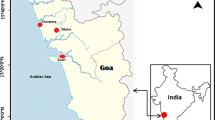Abstract
The metal concentration and body burden of three species of fresh water bivalves, Parreysia cylindrica, Parreysia corrugata and Corbicula striatella were estimated in laboratory experiment after exposure to chronic concentration of arsenic (0.1719 ppm), cadmium (0.23 ppm), copper (0.13 ppm), mercury (0.06 ppm), lead (2.4 ppm) and zinc (5.1 ppm) separately up to 30 days. Dry weight of each animal was used to calculate metal concentrations (μg/g) and the metal body burden (μg/individual). It was observed that zinc, lead and copper concentration and metal body burden was highest in the Corbicula striatella, mercury and arsenic was highest in Parreysia corrugata and cadmium was highest in Parreysia cylindrica. Therefore, Corbicula striatella is being proposed as sentinel organism for monitoring of zinc, lead and copper, Parreysia corrugata for mercury and arsenic, and Parreysia cylindrica for cadmium in fresh water ecosystem.
Similar content being viewed by others
References
APHA (1998) Standard methods for the examination of water and wastewater, 20th edn. American Public Health Association, Washington
Avelar WEP, Mantelatto FLM, Tomazelli AC, Silva DML, Shuhama T, Lopes JLC (2000) The marine mussel Perna perna (Mollusca, Bivalvia, Mytilidae) as an indicator of contamination by heavy metals in the Ubatuba Bay, Sao Paulo, Brazil. Water Air Soil Pollut 118:65–72
Boyden CR (1974) Trace element content and body size in molluscs. Nature 251:311–314
Goksu MZL, Akar M, Cevik F, Findik O (2005) Bioaccumulation of some heavy metals (Cd, Zn, Cu) in two bivalvia species (Pinctada radiate and Brachidontes). Turkish J Vet Anim Sci 29:89–93
Gundacker C (1999) Tissue specific heavy metals (Cd, Pb, Cu and Zn) deposition in natural pollution of Zebra mussel (Dreissena polymorpha Pallas). Chemosphere 38:3339–3356
Huang H, Wu JY, Wu JH (2007) Heavy metal monitoring using bivalved shellfish from Zhejiang Coastal water, East China Sea. Environ Monit Assess 129:315–320
Hung TC, Meng PJ, Han BC, Chuang A, Huang CC (2001) Trace metals in different species of mollusca, water and sediment form Taiwan coastal area. Chemosphere 44:833–841
Ibrahim N, Mat I (1995) Trace element content in relation to the body weight of the marine bivalve, Anadara Granosa with special reference to the application of Inaa and Icp-AES as analytical techniques. J Radioanal Nucl Chem 195(1):203–208
Issam EG, Menge S, Miersch J, Abdelghani G, Ali B, Khalid E, Krauss G-J (2003) Quantification of metallothionien-like protein in the mussel Mytilus galloprovincialis using RP-HPLC fluorescence detection. Environ Sci Technol 37:5739–5744
Jasmine Indra CB, Rajagopalasamy T, Jegatheesan G (1987) Mercury level in the edible oyster, Crassostrea madrasensis. Nat Sem Shellfish Res Farming, Tuticorin. CMFRI Bull 42(II): 414–416
Jung-Suk L, Byeong-Gweon Lee (2005) Effects of salinity, temperature and food type on the uptake and elimination rates of Cd, Cr, and Zn in the Asiatic clam Corbicula fluminea. Ocean Sci J 40(2):79–89
Kennish MJ (2000) Practical handbook of marine science. CRC Press, Boca Raton
Lacastesantos-Fernandez G (2004) Accumulation of mercury and other heavy metals in some edible marine mollusc in sibutad, Zamboanga del Norte. In: 9th national convention on statics (NCS) – Ecosystem management specialist II, Pawczms, denrIX, Zamboanga Penisula
Otchere FA, Joiris C, Holsbeek L (2003) Mercury in the bivalves Anadara (Senilis) senilis, Perna perna and Crassoptera tulipa from Ghana. Sci Total Environ 304:369–375
Paez-Osuna F, Ochoa-Izaguirre MJ, Bojorquez-Leyva H, Michel-Reynoso IL (2000) Macroalgae as biomonitors of heavy metal availability in coastal lagoons from the subtropical Pacific of Mexico. Bull Envrion Contamin Toxicol 64 (in press)
Pillai VK, Ponniah A, Valasala KK, Nair PVR (1986) Heavy metal leads in a few bivalves from coastal waters of south India. Nat Sem Mussel Watch, Cochin, India, (I), pp 93–104
Ullven J (1993) Bivalve compatibility with chlorophenols murtovedessa study. Water and the Environment Government publications—series A, No. 137 51s
Acknowledgments
Financial assistance from University Grants Commission is appreciatively acknowledged.
Author information
Authors and Affiliations
Corresponding author
Rights and permissions
About this article
Cite this article
Waykar, B., Shinde, S.M. Assessment of the Metal Bioaccumulation in Three Species of Freshwater Bivalves. Bull Environ Contam Toxicol 87, 267–271 (2011). https://doi.org/10.1007/s00128-011-0354-4
Received:
Accepted:
Published:
Issue Date:
DOI: https://doi.org/10.1007/s00128-011-0354-4




